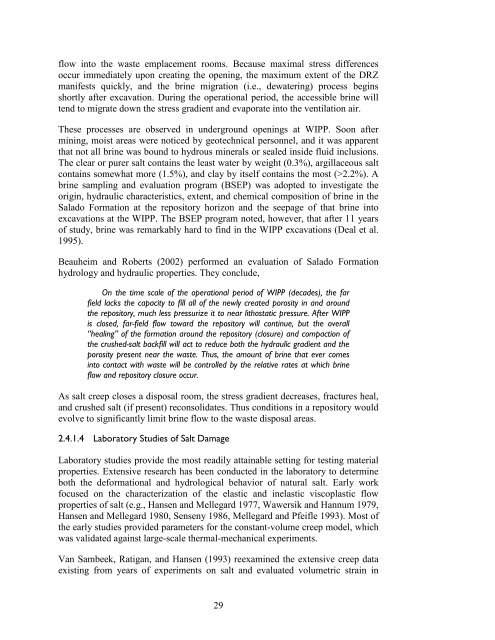Salt Disposal of Heat-Generating Nuclear Waste
Salt Disposal of Heat-Generating Nuclear Waste
Salt Disposal of Heat-Generating Nuclear Waste
You also want an ePaper? Increase the reach of your titles
YUMPU automatically turns print PDFs into web optimized ePapers that Google loves.
flow into the waste emplacement rooms. Because maximal stress differences<br />
occur immediately upon creating the opening, the maximum extent <strong>of</strong> the DRZ<br />
manifests quickly, and the brine migration (i.e., dewatering) process begins<br />
shortly after excavation. During the operational period, the accessible brine will<br />
tend to migrate down the stress gradient and evaporate into the ventilation air.<br />
These processes are observed in underground openings at WIPP. Soon after<br />
mining, moist areas were noticed by geotechnical personnel, and it was apparent<br />
that not all brine was bound to hydrous minerals or sealed inside fluid inclusions.<br />
The clear or purer salt contains the least water by weight (0.3%), argillaceous salt<br />
contains somewhat more (1.5%), and clay by itself contains the most (>2.2%). A<br />
brine sampling and evaluation program (BSEP) was adopted to investigate the<br />
origin, hydraulic characteristics, extent, and chemical composition <strong>of</strong> brine in the<br />
Salado Formation at the repository horizon and the seepage <strong>of</strong> that brine into<br />
excavations at the WIPP. The BSEP program noted, however, that after 11 years<br />
<strong>of</strong> study, brine was remarkably hard to find in the WIPP excavations (Deal et al.<br />
1995).<br />
Beauheim and Roberts (2002) performed an evaluation <strong>of</strong> Salado Formation<br />
hydrology and hydraulic properties. They conclude,<br />
On the time scale <strong>of</strong> the operational period <strong>of</strong> WIPP (decades), the far<br />
field lacks the capacity to fill all <strong>of</strong> the newly created porosity in and around<br />
the repository, much less pressurize it to near lithostatic pressure. After WIPP<br />
is closed, far-field flow toward the repository will continue, but the overall<br />
“healing” <strong>of</strong> the formation around the repository (closure) and compaction <strong>of</strong><br />
the crushed-salt backfill will act to reduce both the hydraulic gradient and the<br />
porosity present near the waste. Thus, the amount <strong>of</strong> brine that ever comes<br />
into contact with waste will be controlled by the relative rates at which brine<br />
flow and repository closure occur.<br />
As salt creep closes a disposal room, the stress gradient decreases, fractures heal,<br />
and crushed salt (if present) reconsolidates. Thus conditions in a repository would<br />
evolve to significantly limit brine flow to the waste disposal areas.<br />
2.4.1.4 Laboratory Studies <strong>of</strong> <strong>Salt</strong> Damage<br />
Laboratory studies provide the most readily attainable setting for testing material<br />
properties. Extensive research has been conducted in the laboratory to determine<br />
both the deformational and hydrological behavior <strong>of</strong> natural salt. Early work<br />
focused on the characterization <strong>of</strong> the elastic and inelastic viscoplastic flow<br />
properties <strong>of</strong> salt (e.g., Hansen and Mellegard 1977, Wawersik and Hannum 1979,<br />
Hansen and Mellegard 1980, Senseny 1986, Mellegard and Pfeifle 1993). Most <strong>of</strong><br />
the early studies provided parameters for the constant-volume creep model, which<br />
was validated against large-scale thermal-mechanical experiments.<br />
Van Sambeek, Ratigan, and Hansen (1993) reexamined the extensive creep data<br />
existing from years <strong>of</strong> experiments on salt and evaluated volumetric strain in<br />
29
















